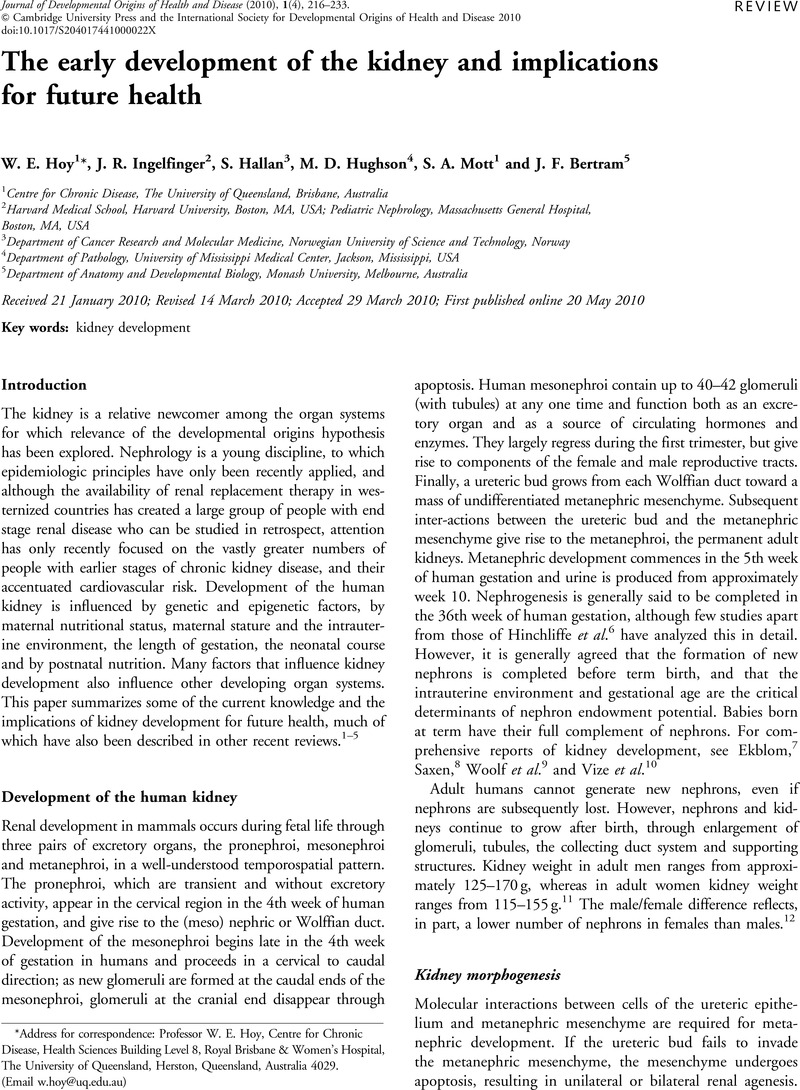Crossref Citations
This article has been cited by the following publications. This list is generated based on data provided by Crossref.
Gubhaju, Lina
Sutherland, Megan R.
and
Black, M. Jane
2011.
Preterm Birth and the Kidney: Implications for Long-Term Renal Health.
Reproductive Sciences,
Vol. 18,
Issue. 4,
p.
322.
Taal, Maarten W.
2011.
Brenner and Rector's The Kidney.
p.
758.
Bertram, John F.
Douglas-Denton, Rebecca N.
Diouf, Boucar
Hughson, Michael D.
and
Hoy, Wendy E.
2011.
Human nephron number: implications for health and disease.
Pediatric Nephrology,
Vol. 26,
Issue. 9,
p.
1529.
Puelles, Victor G
Hoy, Wendy E
Hughson, Michael D
Diouf, Boucar
Douglas-Denton, Rebecca N
and
Bertram, John F
2011.
Glomerular number and size variability and risk for kidney disease.
Current Opinion in Nephrology and Hypertension,
Vol. 20,
Issue. 1,
p.
7.
Walker, Kenneth A.
Cai, Xiaochu
Caruana, Georgina
Thomas, Merlin C.
Bertram, John F.
and
Kett, Michelle M.
2012.
High nephron endowment protects against salt-induced hypertension.
American Journal of Physiology-Renal Physiology,
Vol. 303,
Issue. 2,
p.
F253.
Cullen-McEwen, Luise A.
Armitage, James A.
Nyengaard, Jens R.
and
Bertram, John F.
2012.
Kidney Development.
Vol. 886,
Issue. ,
p.
109.
Cullen-McEwen, Luise A.
Douglas-Denton, Rebecca N.
and
Bertram, John F.
2012.
Kidney Development.
Vol. 886,
Issue. ,
p.
333.
Ingelfinger, Julie R.
and
Nuyt, Anne‐Monique
2012.
Impact of Fetal Programming, Birth Weight, and Infant Feeding on Later Hypertension.
The Journal of Clinical Hypertension,
Vol. 14,
Issue. 6,
p.
365.
Luyckx, Valerie A
Bertram, John F
Brenner, Barry M
Fall, Caroline
Hoy, Wendy E
Ozanne, Susan E
and
Vikse, Bjorn E
2013.
Effect of fetal and child health on kidney development and long-term risk of hypertension and kidney disease.
The Lancet,
Vol. 382,
Issue. 9888,
p.
273.
Bertram, John F
2013.
Estimating glomerular number: Why we do it and how.
Clinical and Experimental Pharmacology and Physiology,
Vol. 40,
Issue. 11,
p.
785.
Bertram, John F.
Cullen-McEwen, Luise A.
Egan, Gary F.
Gretz, Norbert
Baldelomar, Edwin
Beeman, Scott C.
and
Bennett, Kevin M.
2014.
Why and how we determine nephron number.
Pediatric Nephrology,
Vol. 29,
Issue. 4,
p.
575.
Kanzaki, Go
Tsuboi, Nobuo
Haruhara, Kotaro
Koike, Kentaro
Ogura, Makoto
Shimizu, Akira
and
Yokoo, Takashi
2015.
Factors associated with a vicious cycle involving a low nephron number, hypertension and chronic kidney disease.
Hypertension Research,
Vol. 38,
Issue. 10,
p.
633.
Sampogna, Rosemary V.
Schneider, Laura
and
Al-Awqati, Qais
2015.
Developmental Programming of Branching Morphogenesis in the Kidney.
Journal of the American Society of Nephrology,
Vol. 26,
Issue. 10,
p.
2414.
Ingelfinger, Julie R.
Kalantar‐Zadeh, Kamyar
and
Schaefer, Franz
2016.
Em tempo: evitando as consequências da doença renal – foco na infância.
Revista Paulista de Pediatria,
Vol. 34,
Issue. 1,
p.
5.
Ingelfinger, Julie R.
Kalantar-Zadeh, Kamyar
Schaefer, Franz
Kam Tao Li, Philip
Garcia-Garcia, Guillermo
Couser, William G.
Erk, Timur
Ingelfinger, Julie R.
Kalantar-Zadeh, Kamyar
Kernahan, Charles
Osafo, Charlotte
Riella, Miguel C.
Segantini, Luca
and
Zakharova, Elena
2016.
Averting the legacy of kidney disease–Focus on childhood.
Néphrologie & Thérapeutique,
Vol. 12,
Issue. 1,
p.
1.
Ingelfinger, J. R.
Kalantar‐Zadeh, K.
and
Schaefer, F.
2016.
Averting the legacy of kidney disease: focus on childhood.
Internal Medicine Journal,
Vol. 46,
Issue. 2,
p.
133.
Ingelfinger, Julie R
Kalantar‐Zadeh, Kamyar
and
Schaefer, Franz
2016.
World Kidney Day 2016 Averting The Legacy of Kidney Disease–Focus On Childhood.
Journal of Renal Care,
Vol. 42,
Issue. 1,
p.
3.
Hokke, Stacey
Arias, Nicole
Armitage, James A.
Puelles, Victor G.
Fong, Karen
Geraci, Stefania
Gretz, Norbert
Bertram, John F.
and
Cullen‐McEwen, Luise A.
2016.
Maternal glucose intolerance reduces offspring nephron endowment and increases glomerular volume in adult offspring.
Diabetes/Metabolism Research and Reviews,
Vol. 32,
Issue. 8,
p.
816.
Lurbe, Empar
and
Ingelfinger, Julie R.
2016.
Blood pressure in children and adolescents.
Journal of Hypertension,
Vol. 34,
Issue. 2,
p.
176.
Bertram, John F.
Hughson, Michael D.
Puelles, Victor G.
and
Hoy, Wendy E.
2016.
Kidney Development, Disease, Repair and Regeneration.
p.
167.



